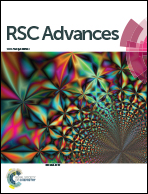Electrospinning synthesis of Co3O4@C nanofibers as a high-performance anode for sodium ion batteries†
Abstract
A unique 1D structure of Co3O4 nanoparticles encapsulated in carbon nanofibers has been fabricated by a facile, cost-effective and scalable electrospinning method followed by a two-step heat-treatment. When tested as an anode for sodium ion batteries, the composite exhibits an initial discharge and charge capacity of 768.4 mA h g−1 and 422.4 mA h g−1 at 50 mA g−1, and retains a reversible specific capacity of ∼300 mA h g−1 up to 100 cycles. At a higher current density of 500 mA g−1, a reversible capacity of 251.7 mA h g−1 is still obtained. Meanwhile, compared to the pure Co3O4 nanofibers, Co3O4@C nanofibers demonstrate much improved capacity retention of 84.3% over 500 cycles. The good electrochemical performance is mainly attributed to the unique 1D nanofiber structure with stable structural integrity and improved electrical conductivity rendered by the carbon nanofiber framework, which is more convenient for the electron transport and Na+ insertion/extraction of the active materials.



 Please wait while we load your content...
Please wait while we load your content...